Yuming Du
Autoregressive Distillation of Diffusion Transformers
Apr 15, 2025Abstract:Diffusion models with transformer architectures have demonstrated promising capabilities in generating high-fidelity images and scalability for high resolution. However, iterative sampling process required for synthesis is very resource-intensive. A line of work has focused on distilling solutions to probability flow ODEs into few-step student models. Nevertheless, existing methods have been limited by their reliance on the most recent denoised samples as input, rendering them susceptible to exposure bias. To address this limitation, we propose AutoRegressive Distillation (ARD), a novel approach that leverages the historical trajectory of the ODE to predict future steps. ARD offers two key benefits: 1) it mitigates exposure bias by utilizing a predicted historical trajectory that is less susceptible to accumulated errors, and 2) it leverages the previous history of the ODE trajectory as a more effective source of coarse-grained information. ARD modifies the teacher transformer architecture by adding token-wise time embedding to mark each input from the trajectory history and employs a block-wise causal attention mask for training. Furthermore, incorporating historical inputs only in lower transformer layers enhances performance and efficiency. We validate the effectiveness of ARD in a class-conditioned generation on ImageNet and T2I synthesis. Our model achieves a $5\times$ reduction in FID degradation compared to the baseline methods while requiring only 1.1\% extra FLOPs on ImageNet-256. Moreover, ARD reaches FID of 1.84 on ImageNet-256 in merely 4 steps and outperforms the publicly available 1024p text-to-image distilled models in prompt adherence score with a minimal drop in FID compared to the teacher. Project page: https://github.com/alsdudrla10/ARD.
FlexiDiT: Your Diffusion Transformer Can Easily Generate High-Quality Samples with Less Compute
Feb 27, 2025



Abstract:Despite their remarkable performance, modern Diffusion Transformers are hindered by substantial resource requirements during inference, stemming from the fixed and large amount of compute needed for each denoising step. In this work, we revisit the conventional static paradigm that allocates a fixed compute budget per denoising iteration and propose a dynamic strategy instead. Our simple and sample-efficient framework enables pre-trained DiT models to be converted into \emph{flexible} ones -- dubbed FlexiDiT -- allowing them to process inputs at varying compute budgets. We demonstrate how a single \emph{flexible} model can generate images without any drop in quality, while reducing the required FLOPs by more than $40$\% compared to their static counterparts, for both class-conditioned and text-conditioned image generation. Our method is general and agnostic to input and conditioning modalities. We show how our approach can be readily extended for video generation, where FlexiDiT models generate samples with up to $75$\% less compute without compromising performance.
Judge Decoding: Faster Speculative Sampling Requires Going Beyond Model Alignment
Jan 31, 2025



Abstract:The performance of large language models (LLMs) is closely linked to their underlying size, leading to ever-growing networks and hence slower inference. Speculative decoding has been proposed as a technique to accelerate autoregressive generation, leveraging a fast draft model to propose candidate tokens, which are then verified in parallel based on their likelihood under the target model. While this approach guarantees to reproduce the target output, it incurs a substantial penalty: many high-quality draft tokens are rejected, even when they represent objectively valid continuations. Indeed, we show that even powerful draft models such as GPT-4o, as well as human text cannot achieve high acceptance rates under the standard verification scheme. This severely limits the speedup potential of current speculative decoding methods, as an early rejection becomes overwhelmingly likely when solely relying on alignment of draft and target. We thus ask the following question: Can we adapt verification to recognize correct, but non-aligned replies? To this end, we draw inspiration from the LLM-as-a-judge framework, which demonstrated that LLMs are able to rate answers in a versatile way. We carefully design a dataset to elicit the same capability in the target model by training a compact module on top of the embeddings to produce ``judgements" of the current continuation. We showcase our strategy on the Llama-3.1 family, where our 8b/405B-Judge achieves a speedup of 9x over Llama-405B, while maintaining its quality on a large range of benchmarks. These benefits remain present even in optimized inference frameworks, where our method reaches up to 141 tokens/s for 8B/70B-Judge and 129 tokens/s for 8B/405B on 2 and 8 H100s respectively.
Movie Gen: A Cast of Media Foundation Models
Oct 17, 2024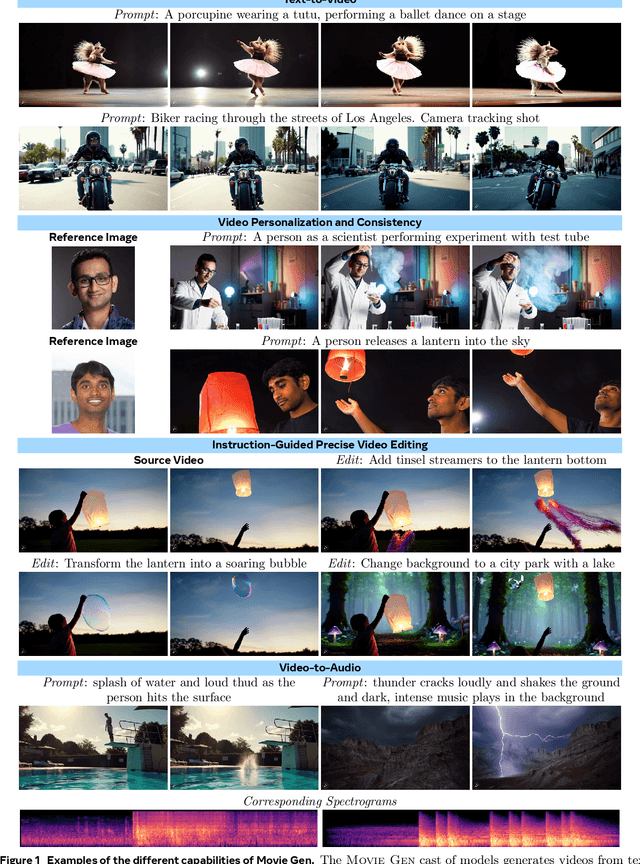

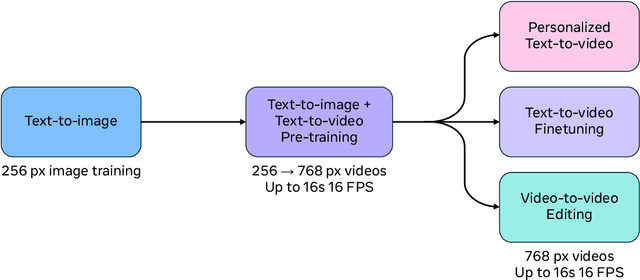
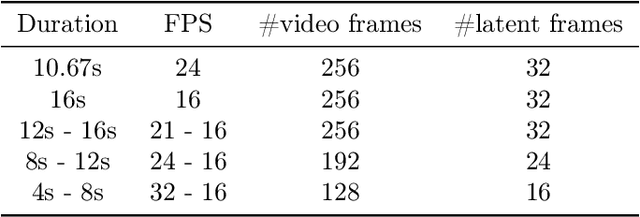
Abstract:We present Movie Gen, a cast of foundation models that generates high-quality, 1080p HD videos with different aspect ratios and synchronized audio. We also show additional capabilities such as precise instruction-based video editing and generation of personalized videos based on a user's image. Our models set a new state-of-the-art on multiple tasks: text-to-video synthesis, video personalization, video editing, video-to-audio generation, and text-to-audio generation. Our largest video generation model is a 30B parameter transformer trained with a maximum context length of 73K video tokens, corresponding to a generated video of 16 seconds at 16 frames-per-second. We show multiple technical innovations and simplifications on the architecture, latent spaces, training objectives and recipes, data curation, evaluation protocols, parallelization techniques, and inference optimizations that allow us to reap the benefits of scaling pre-training data, model size, and training compute for training large scale media generation models. We hope this paper helps the research community to accelerate progress and innovation in media generation models. All videos from this paper are available at https://go.fb.me/MovieGenResearchVideos.
Avatars Grow Legs: Generating Smooth Human Motion from Sparse Tracking Inputs with Diffusion Model
Apr 17, 2023

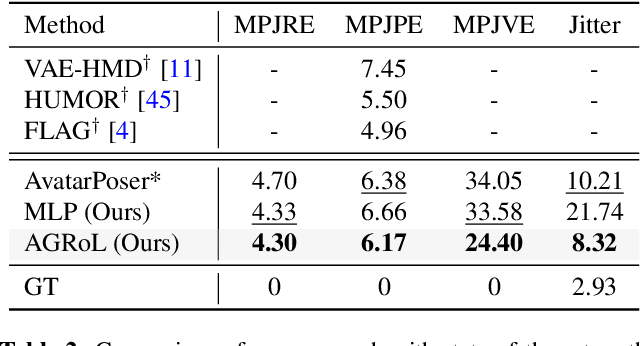
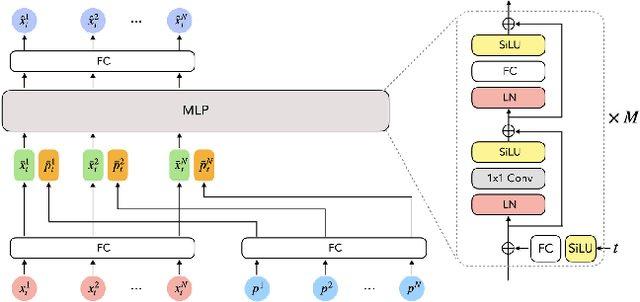
Abstract:With the recent surge in popularity of AR/VR applications, realistic and accurate control of 3D full-body avatars has become a highly demanded feature. A particular challenge is that only a sparse tracking signal is available from standalone HMDs (Head Mounted Devices), often limited to tracking the user's head and wrists. While this signal is resourceful for reconstructing the upper body motion, the lower body is not tracked and must be synthesized from the limited information provided by the upper body joints. In this paper, we present AGRoL, a novel conditional diffusion model specifically designed to track full bodies given sparse upper-body tracking signals. Our model is based on a simple multi-layer perceptron (MLP) architecture and a novel conditioning scheme for motion data. It can predict accurate and smooth full-body motion, particularly the challenging lower body movement. Unlike common diffusion architectures, our compact architecture can run in real-time, making it suitable for online body-tracking applications. We train and evaluate our model on AMASS motion capture dataset, and demonstrate that our approach outperforms state-of-the-art methods in generated motion accuracy and smoothness. We further justify our design choices through extensive experiments and ablation studies.
Multi-Finger Grasping Like Humans
Nov 14, 2022Abstract:Robots with multi-fingered grippers could perform advanced manipulation tasks for us if we were able to properly specify to them what to do. In this study, we take a step in that direction by making a robot grasp an object like a grasping demonstration performed by a human. We propose a novel optimization-based approach for transferring human grasp demonstrations to any multi-fingered grippers, which produces robotic grasps that mimic the human hand orientation and the contact area with the object, while alleviating interpenetration. Extensive experiments with the Allegro and BarrettHand grippers show that our method leads to grasps more similar to the human demonstration than existing approaches, without requiring any gripper-specific tuning. We confirm these findings through a user study and validate the applicability of our approach on a real robot.
* presented at IROS 2022 conference
A Simple and Powerful Global Optimization for Unsupervised Video Object Segmentation
Sep 19, 2022



Abstract:We propose a simple, yet powerful approach for unsupervised object segmentation in videos. We introduce an objective function whose minimum represents the mask of the main salient object over the input sequence. It only relies on independent image features and optical flows, which can be obtained using off-the-shelf self-supervised methods. It scales with the length of the sequence with no need for superpixels or sparsification, and it generalizes to different datasets without any specific training. This objective function can actually be derived from a form of spectral clustering applied to the entire video. Our method achieves on-par performance with the state of the art on standard benchmarks (DAVIS2016, SegTrack-v2, FBMS59), while being conceptually and practically much simpler. Code is available at https://ponimatkin.github.io/ssl-vos.
PIZZA: A Powerful Image-only Zero-Shot Zero-CAD Approach to 6 DoF Tracking
Sep 15, 2022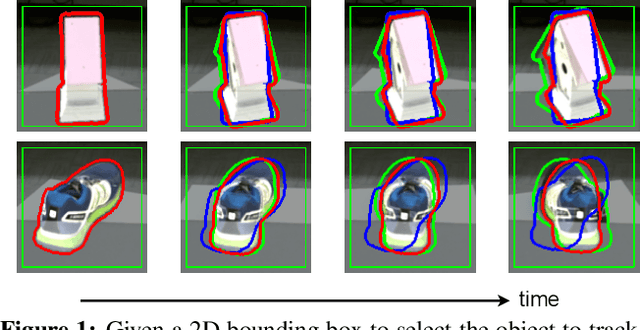



Abstract:Estimating the relative pose of a new object without prior knowledge is a hard problem, while it is an ability very much needed in robotics and Augmented Reality. We present a method for tracking the 6D motion of objects in RGB video sequences when neither the training images nor the 3D geometry of the objects are available. In contrast to previous works, our method can therefore consider unknown objects in open world instantly, without requiring any prior information or a specific training phase. We consider two architectures, one based on two frames, and the other relying on a Transformer Encoder, which can exploit an arbitrary number of past frames. We train our architectures using only synthetic renderings with domain randomization. Our results on challenging datasets are on par with previous works that require much more information (training images of the target objects, 3D models, and/or depth data). Our source code is available at https://github.com/nv-nguyen/pizza
Back to MLP: A Simple Baseline for Human Motion Prediction
Jul 04, 2022



Abstract:This paper tackles the problem of human motion prediction, consisting in forecasting future body poses from historically observed sequences. Despite of their performance, current state-of-the-art approaches rely on deep learning architectures of arbitrary complexity, such as Recurrent Neural Networks~(RNN), Transformers or Graph Convolutional Networks~(GCN), typically requiring multiple training stages and more than 3 million of parameters. In this paper we show that the performance of these approaches can be surpassed by a light-weight and purely MLP architecture with only 0.14M parameters when appropriately combined with several standard practices such as representing the body pose with Discrete Cosine Transform (DCT), predicting residual displacement of joints and optimizing velocity as an auxiliary loss. An exhaustive evaluation on Human3.6M, AMASS and 3DPW datasets shows that our method, which we dub siMLPe, consistently outperforms all other approaches. We hope that our simple method could serve a strong baseline to the community and allow re-thinking the problem of human motion prediction and whether current benchmarks do really need intricate architectural designs. Our code is available at \url{https://github.com/dulucas/siMLPe}.
UVO Challenge on Video-based Open-World Segmentation 2021: 1st Place Solution
Nov 01, 2021


Abstract:In this report, we introduce our (pretty straightforard) two-step "detect-then-match" video instance segmentation method. The first step performs instance segmentation for each frame to get a large number of instance mask proposals. The second step is to do inter-frame instance mask matching with the help of optical flow. We demonstrate that with high quality mask proposals, a simple matching mechanism is good enough for tracking. Our approach achieves the first place in the UVO 2021 Video-based Open-World Segmentation Challenge.
 Add to Chrome
Add to Chrome Add to Firefox
Add to Firefox Add to Edge
Add to Edge